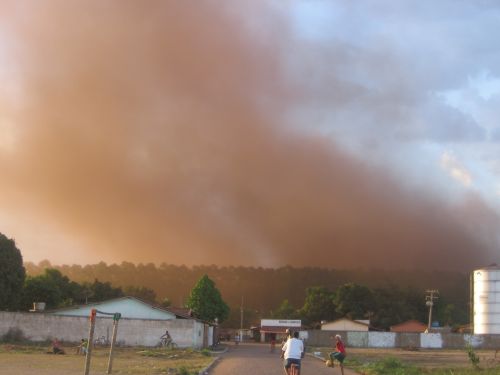Course:SPPH381B/TermProject/Chef Knife - Shirley Deutsch/Iron ore dust
Iron ore mining Hazard - Iron ore dust (causing lung cancer)
Iron Ore Dust
Iron ore dust is a result of iron ore mining. Miners are exposed to dust since most mining occur in closed spaces. This dust enters the lungs and causes inflammation to cells that could result in lung cancer. Such may take years of work with dust before symptoms appear [1] .

What is lung cancer? What causes it, what factors make it worse/better
The body has two lungs, air goes into the lung through the trachea and is divided into smaller airways called bronchi from there the air that the body breathed goes into air sacs called alveoli. From there the oxygen from this air is passed onto the blood stream. There are different types of lung cancer, but most lung cancer starts to develop in the airways[2]. The more advance the cancer becomes, the harder it is to cure it. Lung cancer is commonly found among people over the age of 60 yet many younger people develop lung cancer with the main cause being smoking. Smokers have a higher risk of lung cancer, as chemicals in tobacco smoke are carcinogens that damage cells[3]. Non-smokers have a lower risk of lung cancer yet only 1 of each 10 cases if of a non-smoker. Other cause of lung cancer is air pollution, radiation, chromium or nickel.

What are the health effects associated with lung cancer?
Lung cancer, can spread to other parts of the body, that why it is so important to catch it early. Health effects and symptoms associated with lung cancer are cough (persistent and with blood), chest pains and shortness of breath, loss of energy, weight lost, and change to the shape of the fingers[4].
What level of exposure to Iron Oxide fume is considered safe?
The iron oxide fume OSHA standard is 10mg/m^3 (TWA) over an average eight hour work day [5] . The American Conference of Governmental Industrial Hygienists recommended a 5mg/m^3 (TWA) Thresh-Old Limit Value for exposure [6]. The samples should be taken by a filter near the employee's breathing zone, on an average period of exposure of eight hours and perform an atomic absorption spectrophotometric analysis on the sample.
Who is at the greatest risk?
The exposure route is inhalation and the target organ is the respiratory system. Working in an industry where breathing iron oxide dust or fumes happens on the job increases a worker's risk to lung cancer as a result. Common industries where an occupational disease of lung cancer develops as a result to iron ore dust or fume are common in welding, iron or steel or metal making or working, working with pigments, and of course mining [7] .
How can the risk of workers be reduced?
Common forms of reducing and controlling exposure is by ventilation and personal protective equipment. If an approved respiratory by the Mine Safety and Health Administration is being implemented or by the National Institution for Occupational Safety and Health, the company is also required to invest in a complete resipitory protection program to include regular training, maintenance, and evaluations in order to keep a clean work place [8].
References
- ↑ Ädelroth, E., Hedlund, U., Blomberg, A., Helleday, R., Ledin, M., Levin, J. O., . . . Järvholm, B. (2006, April 01). Airway inflammation in iron ore miners exposed to dust and diesel exhaust. Retrieved April 04, 2017, from http://erj.ersjournals.com/content/27/4/714
- ↑ Occupational Health Guideline for Iron Ore Fume (n.d.). Retrieved April 04, 2017, from https://www.cdc.gov/niosh/docs/81-123/pdfs/0344.pdf
- ↑ Boyd, J. T., Doll, R., Faulds, J. S., & Leiper, J. (1970, April). Cancer of the lung in iron ore (haematite) miners. Retrieved April 04, 2017, from https://www.ncbi.nlm.nih.gov/pmc/articles/PMC1009082/
- ↑ Boyd, J. T., Doll, R., Faulds, J. S., & Leiper, J. (1970, April). Cancer of the lung in iron ore (haematite) miners. Retrieved April 04, 2017, from https://www.ncbi.nlm.nih.gov/pmc/articles/PMC1009082/
- ↑ The National Institute for Occupational Safety and Health (NIOSH). (2016, April 11). Retrieved April 04, 2017, from https://www.cdc.gov/niosh/npg/npgd0344.html
- ↑ Iron oxide dust and fume (as Fe). (2014, December 04). Retrieved April 04, 2017, from https://www.cdc.gov/niosh/idlh/1309371.html
- ↑ Center, R. H. (n.d.). What increases my risk for siderosis? - Siderosis (Iron Dust Inhalation). Retrieved April 04, 2017, from https://www.sharecare.com/health/siderosis-iron-dust-inhalation/what-increases-my-risk-siderosis
- ↑ Occupational Health Guideline for Iron Ore Fume (n.d.). Retrieved April 04, 2017, from https://www.cdc.gov/niosh/docs/81-123/pdfs/0344.pdf